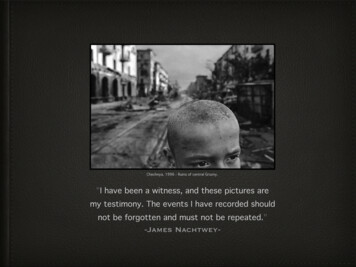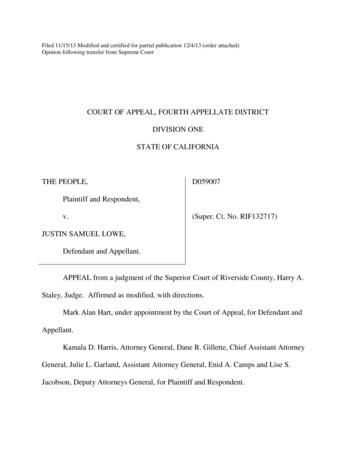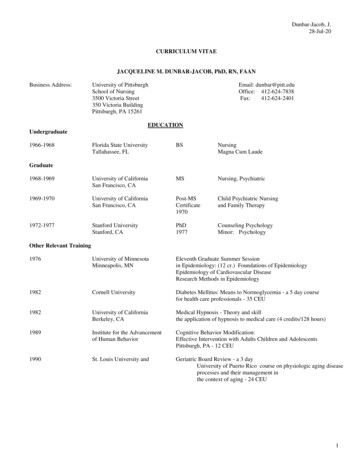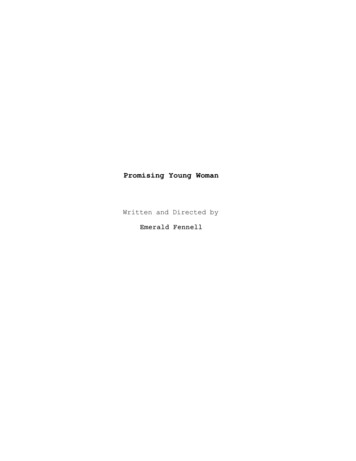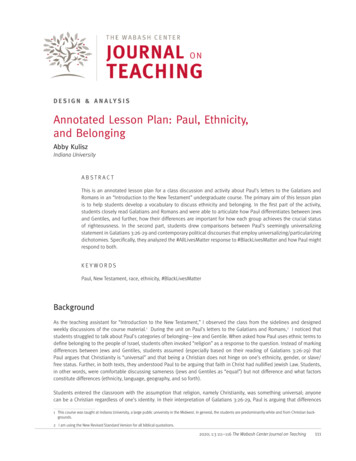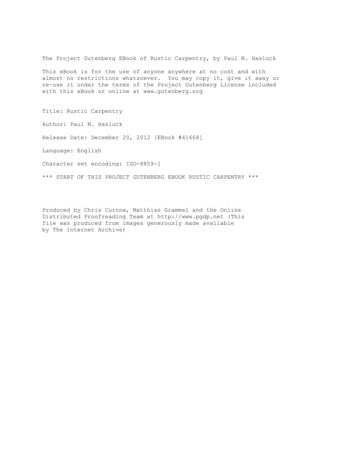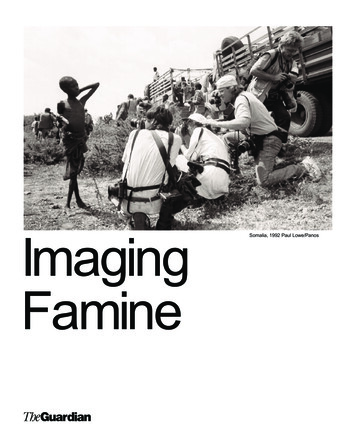
Transcription
ImagingFamineSomalia, 1992 Paul Lowe/Panos
ImagingFamineBand Aid 20. Live 8. Make Poverty History. The G8 Summit inGleneagles. 2005 is witnessing renewed debate about globalpoverty, disasters and development, especially in Africa.Coming two decades after the Ethiopian famine of the mid1980s the time is ripe for a reconsideration of the power andpurpose of disaster pictures, given the way the images of theEthiopian famine spawned the original Band Aid/Live Aidphenomenon.The October 1984 BBC television report from Korem (filmed byMohamed Amin and reported by Michael Buerk) is renownedfor having drawn the world’s attention to the famine in Ethiopia.While it was not the first report of the issue, it is undoubtedlythe most famous. Its eight minutes of searing images movednews professionals and the public alike. This response was notuniversal — “not more starving Africans”, was the reaction ofone network producer. However, another producer identifiedwhat gave the report its power, saying, “it was as if each clipwas an award-winning still photo”. As a result, some 425television stations around the world ran the report, reachinghundreds of millions of people.The media coverage of the Ethiopian famine was a watershedfor how aid agencies thought about images of disaster. TheFood and Agriculture Organisation of the United Nationsundertook an international study of the campaigns andcoverage (called Images of Africa) to see their effects on theEuropean public’s perception of Africa. Out of this came newcodes of practice for the use of pictures by non-governmentalorganisations (NGOs). Since then, reflections on the politics ofphotographic practice with regard to famine have been scantand the persistence of stereotypical images all too evident. Asa result, part of the Live Aid legacy has been the equation offamine with Africa and Africa with famine, reducing a continentof 57 countries, nearly 900 million people and numerousdisparate cultures to a single, impoverished place.2Mohamed Amin and Michael Buerk, Ethiopia, 1984 Camerapix
The purpose of Imaging Famine is to reignite debateabout these issues. To achieve this, the exhibition hassix components: 20 boards detailing themes that have affected faminecoverage in recent decades; two photo essays from Sudan in 1998 by Paul Lowe andTom Stoddart that contrast the work of photojournalists with thenews images on the boards; images from 19th and early 20th century famines to providehistorical context; a gallery of alternative images; interactive screens with interviews where academics, photographers, picture editors and aid agency officials offercontrasting views on the main themes; a website with supplementary information —www.imaging-famine.orgThe exhibition and this catalogue do not claim to haveaddressed all the relevant issues, nor do they answerdefinitively the specific questions posed on the thematicboards. Neither do they present a manifesto on the correct useof images in the media. Instead,they aim to draw publicattention to issues that should animate debate among theproducers and consumers of disaster imagery and toencourage further reflection by all concerned. This cataloguediscusses some of the enduring concerns to give a flavour ofthe main parameters of the debate.The Observer, July 14 1985 Photographer: SebastiaoImaging Famine is an ongoing, web-based project andfeedback is encouraged. Please go to the website for contactdetails on how to submit comments www.imaging-famine.org3
4
Congo, unknown photographer, 1961Oxfam no longer uses images such as this; since the mid-1980s itspolicy has been to represent people fairly and with respect for their dignity. However, it was used extensively in 1961 as part of an ad campaign which is, in part, credited with establishing Oxfam as a household name. Interestingly, the photograph was cropped in the ad — thebare breasted woman to the right was removed, presumably for reasons of “decency”. The photograph, like the image from Madras in1876-77, has been posed and the two naked children have probablybeen instructed to cover their genitalia with their hands.Courtesy of the International Committee of the Red Cross, via OxfamFamine victims, Madras, by Captain Hooper, 1876-77Between 1876 and 1879, approximately 10 million people died as aresult of severe drought and crop failure. This situation was furtherexacerbated by a world economic depression from 1873, which causeda sharp drop in commodity prices. This is one of the earliest extantphotographs of famine victims. Nothing is known of the photographer,Captain Hooper, although his name suggests that he was part of theBritish military presence in India. The image is striking because itseems that the subjects have been posed indoors — the figure to theright is too malnourished to sit up, and thefigure to the left on the floor seems to be supported by a rope. There isan extraordinarily dispassionate quality to the image on the part of thephotographer, perhaps explained by the fact that, until relatively recently, famines were seen as natural occurrences, nature’s way of rightingitself; in other words, the agency of God.5
6
Illustrations of a Chinese Famine,unknown artist, 1878Between 1876 and 1879, approximately 13million people died throughout China due tosustained monsoons in the Guangdong andFujian regions, and drought in much of thenorth. Environmental conditions were compounded by corrupt administration. Theseillustrations were published in England in 1878specifically to raise awareness of the dire situation. The illustrations belie the gruesomesubject matter, which shows the stripping ofbark and leaves from trees and thatch fromhouses for food, the selling ofchildren into slavery, and suicide.The Famine in China, Illustrations by a NativeArtist, London: China Famine ReliefFund/Kegan Paul & Co., 1878Famine victims, Allahabad, unknown photographer, 1901Between 1896 and 1902, approximately 19 million perished in India during a period of repeated monsoon failure. Most of the victims perished asa result of diseases such as malaria, bubonic plague, dysentery, smallpoxand cholera. These extraordinary photographs of the famine dead, takenby an unknown German photographer, are extremely early examples ofimages which make no attempt to dilute the horror of what is happening.However, these images predate mass photojournalism by some threedecades and were possibly taken by a “tourist” for his or her private consumption. It was not until the Holocaust that extreme images like thisgained a wider currency.Courtesy of the Sean Sexton Collection7
what is the appeal?Charity appeals are organised around often stereotypicalimages of victims. These appeals raise millions of pounds,thereby demonstrating the continuing power of the pictures.But are these short term benefits offset by the long-term effectsof reproducing images with cultural and racial stereotypes?The Guardian, June 19 2002 Photograph: Daily Mirror, courtesy ofMirror Group Newspapers8
positive versusnegative imagesWar and famine are newsworthy. Suffering and disastercapture media attention. But are the images associated withsuch reporting necessarily negative? Is it possible for themedia to present positive images of people in need? Wouldsuch images be appropriate if they minimised the scale ofsuffering? Are negative images inherently necessary forfundraising by development NGOs, or do they only breeddespair and a sense that nothing can be done about seeminglyintractable situations?One way to answer such questions is to highlight moralimperatives to tell the truth, avoid sensationalism and respectthe dignity of human beings (however awful their situations).Such considerations apply to both the news media anddevelopment NGOs, even though different producers andconsumers of images require different pictures. For the media,the emphasis is on accuracy and immediacy. For aid agencies,one response is to draw a temporal distinction betweenfundraising as a short-term imperative and education as a longterm aim, or between short-term emergencies andlong-term development. Here, positive images may be seenas those that reflect positive stories about long-term projectsdesigned to achieve sustainable development. Another wayto emphasise the positive would be to focus on positiveoutcomes — the way that funds raised for humanitarianassistance have reached their designated targets and savedlives, for example.The Guardian, May 2 1992 Photographer: David Steward-An unresolved issue is whether the ends necessarily justify themeans. If morally suspect images cause people to act (eitherby donating money for disaster relief or lobbying for politicaljustice) then should they be avoided at all cost? Is an imagenecessarily negative if it produces a positive outcome?9
the nature ofphotojournalismThe impact of a well-chosen photograph is immediate, and apowerful way to get a message across. And yet images canalso be greatly changed by the addition of captions and text.Indeed, an image without a caption is arguably purely aesthetic(like a family portrait), short of clear meaning and not photojournalism at all. But what exactly is the purpose of caption andtext? Is it simply to say what the picture is about, or is it meantto challenge assumptions, tell a story, convey a message,advertise good work, raise consciousness, raise funds, androuse emotions?Complicating those questions is the issue of who is writingcaptions and text. As the witness, that task is predominantly thephotographer’s. But photographers are only one link in anincreasingly global image production and distribution chain.They may not have free reign to shoot whatever they desire,and they do not control how the images appear in the press,to whom they are sold, and the way they are then captioned,titled or positioned in relation to articles. Photographers’material is edited through various filters by others, includingphoto agencies and picture editors, who may have conflictingpriorities. Another enduring issue is therefore the extent towhich photojournalism can appropriately provide images withcontext, understanding and explanation. This may depend onother factors, such as whether a photographer has the licenceto provide multiple images, whether the photographer’s subjectis a hot topic at the time, and whether it is a quiet news day ornot.The Observer, August 9 1992 Photographer: Andy Hall10
geographies ofdeath anddisaster“Location, location, location,” writes Susan Moeller inCompassion Fatigue. She goes on to cite an Americannewsroom truism: “One dead fireman in Brooklyn is worth fiveEnglish bobbies, who are worth 50 Arabs, who are worth 500Africans.” The suggestion here is that audiences care mostabout those with whom they identify. But then what are thebases of identification? Is it physical proximity that matters,or markers of belonging such as nation and race? Do peoplewho are perceived as distant kin — such as Australians —necessarily garner more coverage than Ethiopians orSudanese, for example? If so, how can other areas commandpublic attention?The newsroom truism implies that foreign stories are onlynewsworthy if they involve death and disaster on a massivescale. So how many have to die before a distant eventbecomes news? The answer to that question is not as clear-cutas it might seem because it depends on a number of factors.Are newspaper editors (who may have very clear ideas of whatinterests their audiences) equally attuned to all events? Howare the events themselves understood — as natural disastersor as complex political emergencies? Is it a slow news day(such as Boxing Day, for example, when the 2004 tsunamistruck)? Are economic or political interests perceived to beat stake? Are westerners (tourists, aid workers or soldiers)caught up in the situation or implicated in wrongdoing? Arephotographers and reporters available at the scene to provideimages and stories? And are innocent victims in ready supply?Monrovia, Liberia, 2003Liberian Red Cross workers collect the body of a youngboy killed by a stray mortar. Downtown Monrovia is heavilypopulated, including tens of thousands of displaced people.All are vulnerable to such mortar attacks. The ongoing conflictin Liberia intensified in March 2003 when rebels opposed tothe government of Charles Taylor gained territory acrossmuch of the country. In August 2003, Taylor agreed to handover power to an interim government and went into exile,which led to the signing of a peace agreement.Martin Adler/Panos Pictures11
The Guardian, December 16 1992 Photographers: Jerome Delay and Jim12
moving imagesFamine images (both in the fundraising campaigns of aid agencies and innewspaper reports) tend to focus on the suffering of women and children.The child sometimes stares into the camera in an accusatory or plaintiveway. More often than not, mother and child simply weep. Are suchphotographs different from the 19th-century images of the poor anddestitute produced by European missionaries in Asian and Africa? Ifnot, what does this persistence in form and content tell us? Has “disaster”photography gone beyond its historical connections to the rise ofanthropology and the practice of colonialism? Is contemporaryphotographic practice post-colonial?“Victim” images appear destined to arouse the emotions of viewers.Children in particular raise strong feelings when they’re portrayed asespecially vulnerable and weak (at the moment of death, for example, orhaving been orphaned). Photographs that convey emotional distress maybe intended as mere visual representations of suffering, or as signs ofsocietal collapse. They may also consciously elicit the sympathy, pity andcompassion of viewers, in the belief that emotional responses attractattention to stories or stimulate charitable giving.However, the extent to which viewers are actually moved (and if so, how)by emotional images remains debatable. The “compassion fatigue” thesishas it that endless repetition of upsetting images is not a recipe for politicalunderstanding, on the one hand, or humanitarian relief on the other, if itinduces passivity, despair, helplessness or confusion among viewers andreaders. Far from reaching for their wallets to give aid, this thesis suggeststhat consumers turn away and switch off. A contrasting view claims thereis a “CNN effect” where the broadcast or publication of powerful imagescan force governments to act.Another thesis was put forward by Sir Bob Geldof in recent televisiondocumentaries about Band Aid/Live Aid. Rather than feeling pity andsympathy, Geldof has suggested, the purchasers of the original Band Aidsingle were moved by anger and outrage. Whereas sympathy may beproductive of a charitable impulse, the suggestion is that strongeremotions are required to harness public mobilisation for political justiceand change. Is there any evidence, then, that some images have beenpowerful enough (either on their own or mediated through public opinion)to prompt governments to act or change tack?13
pictures, celebritiesand policyThe BBC’s 1984 Amin/Buerk report on the famine in Ethiopiaprovoked an unprecedented response from the British public,who had already given generously to a national appeal a fewmonths earlier. Aid agencies were deluged overnight with offersof money. Released in November 1984, the Band Aid single DoThey Know It’s Christmas? was followed in 1985 by the LiveAid concerts in London and Philadelphia — events that stimulated further giving by showing images of dying Ethiopianchildren to a vast audience. Those same images — from aCanadian Broadcasting Corporation short film, set to the Carssong Drive — were shown again 20 years later to theperformers on the Band Aid 20 reprise single as well as used atthe press launch of Live 8. Similar images still feature in manycharitable appeals and still continue to shock when printed inthe papers or screened on the news.Through its use of celebrities to obtain media attention andraise awareness, Live Aid was unquestionably successful instimulating charitable giving. But to what extent did Live Aid(or celebrities in general) provide any real depth of politicalunderstanding or provoke political change? It’s easy to forgetthat Sir Bob Geldof’s personal political crusade (in the wake ofthe Amin/Buerk report) was ultimately against the CommonAgricultural Policy (CAP) of the European Union and not simplyagainst African dictators and insufficient aid. But have effortssuch as these produced any noticeable rise in the level ofpublic understanding of the global forces that affect countries inAfrica? Even more importantly, have short-term moralimperatives to act to relieve suffering provoked deeperquestions about (and changes to) long-term developmentpolicy? Has any of this public controversy and debate changeda government’s agenda? Continuing calls for the eliminationof farm subsidies in the US and Europe, and an end to the CAPfor Africa’s sake, suggests that enduring political issues remainunresolved. It questions what sorts of images would berequired to effectively stimulate structural change.14Daily Mail, December 2 1992
stereotypes, iconsand symbolsenduring stereotype of the African continent as a “country”neither urban, modern nor efficient, and where everyone ispermanently malnourished.Is there more to the Live Aid legacy, though, than thereproduction of negative stereotypes? On the positive side,Live Aid has been credited with instilling widespreadrecognition that the fate of the many countries in Africa is ourlong-term responsibility; that it is a continent where we need towork with indigenous forces promoting major change andfuture care as opposed to an emergency band aid. Celebritiesremain active on the issues of debt, aid and development, andthrough forums such as the Commission for Africa, politicalagendas are being promoted in concert with African leaders. Asfor the general public, Michael Buerk has credited Live Aid withthe very opposite of compassion fatigue, suggesting insteadthat the celebrity activism of the 1980s convinced ordinarypeople of their capacity to effect change.The New York Times, July 13 2003No country, let alone continent, is defined by famine. Yetstudies of British people suggest that perceptions of Africancountries remain dominated by negative stereotypes of famine,war and poverty to such an extent that Africa is regarded as asingle, impoverished place. While women are often portrayedin ways that conform to gender stereotypes of helplessness,motherhood and dependence on men, images of starvingchildren with bloated bellies and flies around their eyes havebecome icons of weakness and deprivation. In concert withsymbolic images of western aid (such as tents, sacks of grainand aid workers), these add up to distorted views of Africa asone big begging bowl — a place beset by tribal wars, corruptleaders and uncontrollable natural disasters such as chronicdrought. This is what is meant by the Live Aid legacy — theHowever, the very willingness of ordinary citizens to purchasecommodities such as the Band Aid 20 single and Make PovertyHistory wristbands returns the spotlight to the issue of whether“negative” images are required to move people to act. Aidagencies and the media have been faulted for recycling thesame narrow set of images. But they are not the only culprits.The cover of the Band Aid 20 single featured an emaciatedAfrican child standing amid polar bears and reindeer, just asthe first Band Aid single featured two fly-blown African childrensurrounded by toys.To what extent, then, is there a market for images thatmight surprise and delight? Why do we not regularly seenon-traditional images (of cultural, political and sporting events,for example) that disrupt stereotypes? Are war, famine andpoverty the only newsworthy items? Even if the answerto that is an unqualified yes, are the most powerful imagesnecessarily those that reinforce cultural cliches as opposedto the more complex ones that attempt to convey knowledge,understanding, context and explanation? And are indigenousphotographers with local knowledge any more likely thanones to produce challenging images?15
Daily Mirror, May 21 2002 Photographer: Mike Moore Courtesy of Mirror Group Newspapers16
Dakar, Senegal, 2002The pack passes a mosque along the coastline on the outskirts of Dakar. The Tour du Senegal, a two-week cycle raceheld in average temperatures of 40C, traverses the countrywith a total distance of 1168km.Chris Keulen/Panos PicturesKhartoum, Sudan, 2004Shopping mallPetterik Wiggers/Panos Pictures17
visual memoryWhich technology dominates the news media: still or movingimages? Biafra in the late 1960s was perhaps the last conflictwhere photojournalists scooped television crews for pictures ofthe crisis. But if moving images are now dominant andubiquitous, does that mean still images have lost theirsignificance? Almost certainly not, though the way in whichthey are regarded as significant could have changed.Photojournalism and documentary photography remain aculturally significant source of knowledge. As much as peopleare rightly sceptical about the inherent objectivity of the image,photographs retain a gravitas that the everyday andall-consuming stream of television can find hard to match.Will still photography gain a renewed importance as televisionincreasingly neglects the world beyond our tabloid concerns?Is it the case that we remember events in terms of single, stillphotographs rather than streams of video?Those iconic images that we can readily recall often invokeother pictures. They might look like paintings, or recall otherhistorical photographs, or invoke the conventions of Christianiconography — mother and child in a Madonna-like pose, or aidworkers adopting the form of a healing saviour. Are suchimages just reflections of what is in front of the lens? Or has thephotographer directly or indirectly relied on established artistictraditions to produce a powerful picture?Daily Mirror, December 17 1974 Photographer: Eric Piper courtesy of Mirror Group Newspapers18
time and placeSudan, 1998 Photographer: Tom StoddartNew technologies have brought new opportunities.Photographers shooting in Los Angeles, Liverpool or Limaupload their images to global picture desks in places such asSingapore, where they are edited and transmitted digitally tothe desktops of picture editors around the world. The wholeprocess should only take a few minutes — any longer and thecompetition will have the edge. Immediacy is the key. But doesthis mean that the independent photographer’s eye is beingreplaced by the need for impact, speed and the understandingof a global audience? Does this force the use of simplifiedfamiliar compositions?Tight competition means tight budgets. It is rare to sendphotographers for months to document an ongoing crisisparticularly in a place unfamiliar to those who control thecommissions. Can a photographer be expected to reflect onthe complexity of an issue they have only been introduced tothe day before — or do they just invoke the stock concerns ofthose who dispatched them? What is the difference, if any,between images produced by rising numbers of localphotographers in Asia and Africa and those sent in from theglobal north? There is a move towards training and usingindigenous image makers, but will they be allowed anindigenous voice or will the predominantly northern marketdemand the northern perspective? And what happens to theimages of places least requested, when loaded into databasesthat search by popularity?As lifestyle issues and celebrity features devour the pages ofthe weekend supplements, the serious photo essay is oftencompressed to a single image. Can a photographer beexpected to give an understanding to his/her audience with justone picture? If this is the future, what can be learned fromadvertisers who have mastered the art of triggering anemotional response through visual metaphors?19
responsibilityWhere does this leave photography in the process ofresponding to humanitarian disaster? Are photographerssimply image workers, or do they have wider responsibilities?Faced with suffering, do they take the picture or dole out aid?Kevin Carter, who shot the 1993 Pulitzer Prize-winning imageof the vulture and child in Sudan, was repeatedly criticised bynewspaper readers for not assisting the child directly. Shouldthere be a moral code which guides photographers on when toact or is their responsibility best exercised by taking thepictures?Probably the world’s worst famine occurred in China between1959 and 1961, where an estimated 40 million people died.Chinese photographers were present but due to a combinationof local culture, political power and lack of resources anypictures they did take were not publicly used. Text reportswere common at the time with much debate in the British newspapers over how to deal with the issue. However with nopictures, there was no proof and no action. Would there havebeen the same massive response to the 1984 Ethiopian famineif Michael Buerk had produced a report without MohamedAmin’s images?What about the opinions of the people who appear in disasterphotographs? The photographer is often criticised for notconsidering the dignity of their subjects — for preying onpeople at the lowest moment of their lives, too weak to mustera response or run from the gaze of the lens. Or could it be thatthis is all victims of atrocity and disaster can do? Bephotographed. Is this in itself a strategy for survival, offeringtheir image in return for aid provided by an organisation thatneeds those pictures to raise the funds to buy that aid?The Guardian, August 18 1997 Photographer unknown20
The New York Times, March 26 1993 Photographer: Kevin Carter21
Imaging FamineReferencesBob Smith with Salim Amin, The ManWho Moved the World: The Life andWork of Mohamed Amin (Nairobi:Camerapix Publishers International,1998).Susan D Moeller, Compassion Fatigue:How the Media Sell Disease, Famine,War and Death (New York and London:Routledge, 1999).Food and Agriculture Organisation,Images of Africa, available atwww.imaging-famine.org/resourcesThis text was written by David Campbell,DJ Clark and Kate Manzo, with researchassistance from Caitlin Patrick,July 2005.CuratorsDavid Campbell is professor of culturaland political geography at DurhamUniversity, and associate director of theDurham Centre for AdvancedPhotography Studies. His books includeNational Deconstruction: Violence,Identity and Justice in Bosnia(Minneapolis: University of MinnesotaPress, 1998), and Moral Spaces:Rethinking Ethics and World Politics,edited with Michael J Shapiro(Minneapolis: University of MinnesotaPress, 1999). National Deconstructionwas named International Forum Bosnia’sBook of the Year 1999, and wastranslated and published in Sarajevo in2003. Campbell has published a seriesof essays on the politics of photography,including “Salgado and the Sahel:Documentary Photography and theImaging of Famine” in Rituals ofMediation: International Politics andSocial Meaning, edited by FrancoisDebrix and Cindy Weber (Minneapolis:University of Minnesota Press, 2003),and “Horrific Blindness: Images of Deathin Contemporary Media”, Journal ofCultural Research 8 (2004). He iscurrently working on a book project22entitled Humanitarian Visions, whichexplores the visual culture (especially thepictorial representation of war, famineand atrocity) of international politics andpolitical geography.DJ Clark is lecturer and programmeleader on the MA photography at theUniversity of Bolton, a photojournalistrepresented by Panos Pictures, and iscompleting a PhD in the geographydepartment at Durham University. In2003 he was awarded a WinstonChurchill travelling fellowship forresearch in Bangladesh and Ethiopiawhich was published in “The Productionof a Contemporary Famine Image”,Journal of International Development,16 (2004). He has also authored aforthcoming article “China, Photographyand Famine”.Kate Manzo is lecturer in internationaldevelopment in the school of geography,politics and sociology at the University ofNewcastle. She has published widely onrace, nationalism and development,including Creating Boundaries: ThePolitics of Race and Nation (Boulder:Lynne Rienner, 1996), “Africa in the Riseof Rights-based Development,”Geoforum, 34 (2003), and “ExploitingWest Africa’s Children: Trafficking,Slavery and Uneven Development,” Area(forthcoming 2006). She is currentlyworking on a project called Baby Face:Images of Suffering in Social JusticeCampaigns, which asks whether the useof stereotypical imagery of Africa canever be justified.Research associateCaitlin Patrick holds an MA in politicalscience from York University in Toronto,and is working on a PhD in thegeography department at DurhamUniversity, having been awarded a SocialSciences and Humanities ResearchCouncil of Canada doctoral fellowship.Her dissertation research is concernedwith the print and television mediacoverage of the 1992-93 US/UNintervention in Somalia, and investigateswhether this coverage influencedpolicymakers’ and public understandingof the intervention. Her broad researchinterests include political theory, visualculture and global geopolitics, andgender issues in global politics.ConsultantPaul Lowe is a photojournalist with over15 years’ experience working in warzones such as Bosnia and Chechnya aswell as covering famines in Somalia andSudan. Represented by Panos Pictures,his work has been widely published inmajor national and internationalpublications, as well as in his bookBosnians (London: Saqi Books, 2005).Lowe is programme leader on the MA inphotojournalism and documentaryphotography, London College ofCommunication, University of the Arts,London, where he is also undertakingPhD research on the aesthetics andethics of contemporary photographicpractice.AcknowledgmentsThe curators would like to express theirthanks to the following individu
purpose of disaster pictures, given the way the images of the Ethiopian famine spawned the original Band Aid/Live Aid phenomenon. The October 1984 BBC television report from Korem (filmed by Mohamed Amin and reported by Michael Buerk) is renowned for havi
